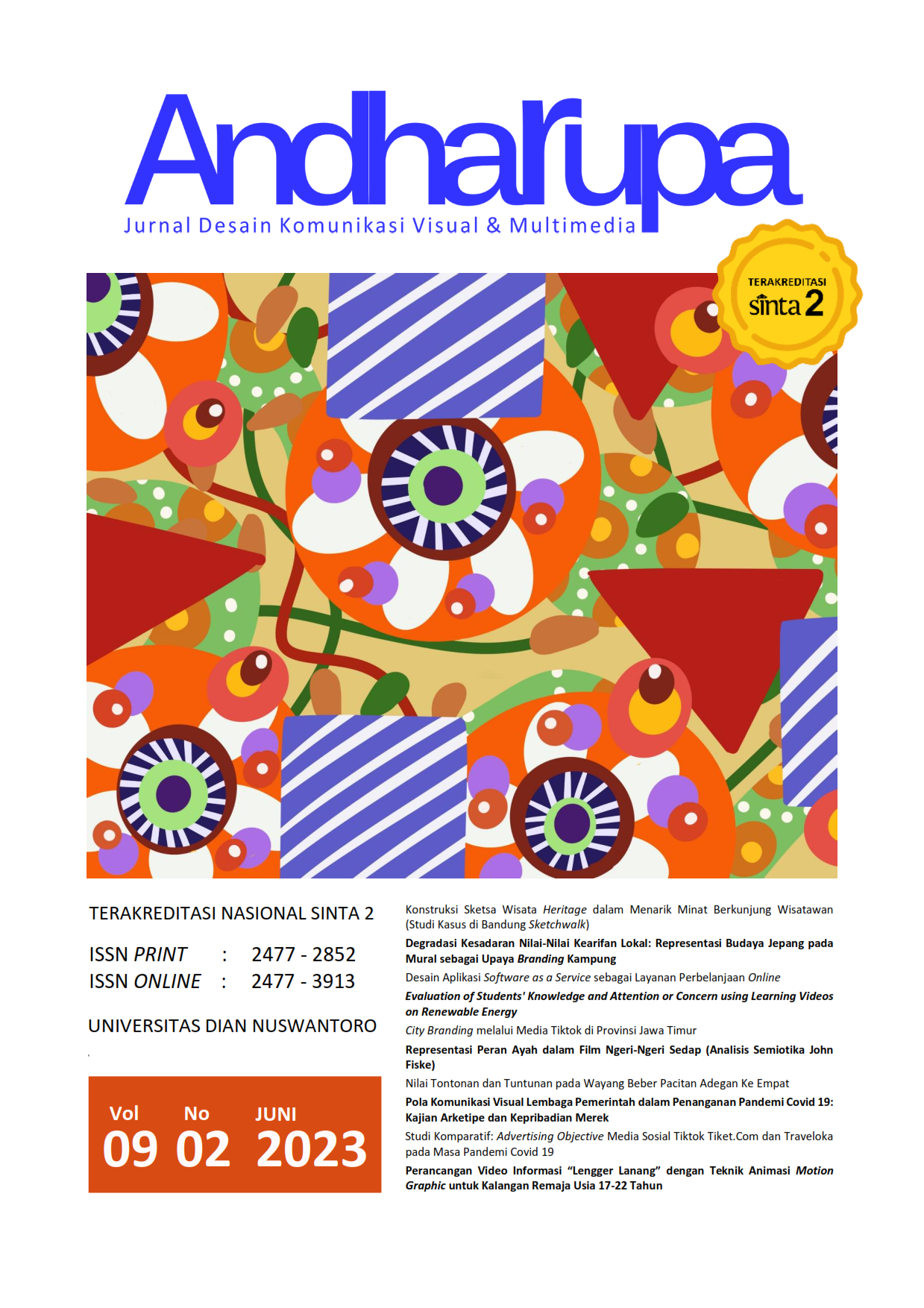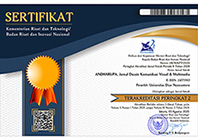Pola Komunikasi Visual Lembaga Pemerintah dalam Penanganan Pandemi Covid 19: Kajian Arketipe dan Kepribadian Merek
DOI:
https://doi.org/10.33633/andharupa.v9i02.7489Abstract
AbstrakPenelitian ini bertujuan untuk menganalisis kepribadian merek Kementerian Kesehatan Republik Indonesia (Kemenkes RI) melalui akun media sosial Instagram dengan menggunakan perspektif Semiotika Multimodal dan menghubungkannya dengan arketipe merek untuk menentukan level The Caregiver lembaga tersebut. Dalam penelitian ini, dilakukan pendekatan kualitatif dengan fokus pada analisis pola komunikasi Kemenkes RI terkait COVID-19 melalui media sosial Instagram. Teknik analisis data yang digunakan adalah semiotika multimodal dan pendekatan metafungsi. Temuan penelitian menunjukkan bahwa Kemenkes RI memiliki karakteristik The Caregiver level tiga: altruisme, yang menunjukkan kepedulian terhadap dunia yang lebih besar dan memprioritaskan kepentingan masyarakat Indonesia. Tema-tema seperti mengayomi dan melindungi muncul dalam analisis semiotika multimodal. Selain itu, Kemenkes RI juga menggunakan storytelling dengan pendekatan visual seperti komik untuk mengurangi ketakutan dan kebingungan pada masyarakat. Kata kunci: Arketipe Merek, Covid-19, Kemenkes, Keperibadian Merek, Pola Komunikasi, Semiotika Multimodal AbstractThis research aims to analyze the brand personality of the Ministry of Health of the Republic of Indonesia (Kemenkes RI) through its Instagram social media account using the Multimodal Semiotics perspective and linking it to the brand archetype to determine the level of The Caregiver of the institution. This qualitative research focuses on analyzing Kemenkes RI's communication patterns related to COVID-19 through Instagram social media. The data analysis technique used is multimodal semiotics and the metafunction approach. The findings show that Kemenkes RI exhibits The Caregiver level three characteristics: altruism, indicating concern for the larger world and prioritizing the interests of the Indonesian community. Themes such as nurturing and protecting emerge in multimodal semiotic analysis. Additionally, Kemenkes RI uses visual storytelling, such as comics, to reduce fear and confusion among the public. Keywords: Brand Archetype, Brand Personality, Communication Patterns, Covid-19, Kemenkes, Multimodal SemioticsReferences
Bechter, C., Farinelli, G., Daniel, R.-D., & Frey, M. (2016). Advertising between Archetype and Brand Personality. Administrative Sciences, 6(2), 5.
Chohan, U. W. (2020). A Post-Coronavirus World: 7 Points of Discussion for a New Political Economy. SSRN Electronic Journal.
Covid19.go.id. (2022). Tim Pendukung | Satuan Tugas. Covid19.Go.Id.
Fahrika, A. I., & Juliansyah Roy. (2020). Dampak pandemi covid 19 terhadap perkembangan makro ekonomi di indonesia dan respon kebijakan yang ditempuh. Inovasi Unmul, 2(16), 206–213.
Firman. (2015). Membangun Inovasi Birokrasi Melalui Teknologi Informasi dan Komunikasi (TIK). Transformative, 1(2), 134–146.
Flynn, S. V., & Black, L. L. (2013). Altruism–Self-Interest Archetypes: A Paradigmatic Narrative of Counseling Professionals. The Professional Counselor, 3(2), 54–66.
Haddad, L., Hamza, K. M., & Xara-Brasil, D. M. (2015). Archetypes and brand image: an international comparison. Australian Journal of Basic and Applied Sciences, February 2020, 22–31.
Hyland-Wood, B., Gardner, J., Leask, J., & Ecker, U. K. H. (2021). Toward effective government communication strategies in the era of COVID-19. Humanities and Social Sciences Communications, 8(1), 1–11.
Kress, G., & Leeuwen, T. Van. (2006). Reading Images; The Grammar of Visual Design (2nd ed.). Routledge.
Maatota, F. T., Lapian, J., & Tielung, M. V. J. (2019). Content Analysis of Storytelling Elements and Brand Archetype of Linkedin Ad Campaign. Jurnal EMBA: Jurnal Riset Ekonomi, Manajemen, Bisnis Dan Akuntansi, 7(4), 5643–5653.
Mark, M., & Pearson, C. S. (2001a). The Hero and The Outlaw: Building Extraordinary Brand Through the power of Archetypes (1st ed.). McGraw Hill Professional.
Mark, M., & Pearson, C. S. (2001b). The Hero and the Outlaw: Building Extraordinary Brands Through the Power of Archetypes. McGraw-Hill.
Meleong, L. J. (2005). Metodologi Penelitian Kualitatif (p. 4). Remaja Rosdakarya.
Mirzaee, S., & George, B. P. (2016). Brand Archetypes: An Experiment with the “Demeter”. Journal of Applied Economics & Business Research, 6(2), 93–105.
Muhyiddin, M., & Nugroho, H. (2021). A Year of Covid-19: A Long Road to Recovery and Acceleration of Indonesia’s Development. Jurnal Perencanaan Pembangunan: The Indonesian Journal of Development Planning, 5(1), 1–19.
Nugroho, R. S., & Audinovic, V. (2022). The discourse of COVID-19 vaccine in the Indonesian Ministry of Health Instagram @kemenkes_ri. Masyarakat, Kebudayaan Dan Politik, 35(4), 496–513.
Sammut Bonnici, T. (2015). Brand and Branding. Wiley Encyclopedia of Management, 12(January 2015), 1–3. https://doi.org/10.1002/9781118785317.weom120161
Sofian, A. (2020). The Implementation of Halliday ’s Persuasive Strategy. 1, 207–214.
Unsworth, L. (2008). Multimodal Semiotics: Functional Analysis in Contexts of Education. In Multimodal Semiotics: Functional Analysis in Contexts of Education (pp. 187–200). Continuum International Publishing Group.
Velarosdela, R. N. (2021). Awal Mula Varian Delta Masuk ke Jakarta hingga Mendominasi 90 Persen Kasus Covid-19. Kompas.Com.
Venne, R. (2005). Mainstreaming the concerns of older persons into the social development agenda. … Secretariat. Division for Social Policy and Development, II, 1–15.
Weber, A. (2002). Feeling the signs: The origins of meaning in the biological philosophy of Susanne K. Langer and Hans Jonas. Sign Systems Studies, 30(1), 183–200.
Wijaya, B. S. (2018). Govermental Branding as Strategy to Build Public’s Trust, Loyalty, and Participation. Journal Communication Spectrum, 8(2).
Xara-Brasil, D., Miadaira Hamza, K., & Marquina, P. (2018). The meaning of a brand? An archetypal approach. Revista de Gestão, 25(2), 142–159.
Zook, P. S. (2020). Marketing Communications Integrating Online and Offline, Customer Engagement and Digital Technologies (Seventh). KoganPage.
Downloads
Published
Issue
Section
License
Authors who publish with this journal agree to the following terms:
- Authors retain copyright and grant the journal right of first publication with the work simultaneously licensed under a Creative Commons Attribution License that allows others to share the work with an acknowledgment of the work's authorship and initial publication in this journal.
- Authors are able to enter into separate, additional contractual arrangements for the non-exclusive distribution of the journal's published version of the work (e.g., post it to an institutional repository or publish it in a book), with an acknowledgment of its initial publication in this journal.
- Authors are permitted and encouraged to post their work online (e.g., in institutional repositories or on their website) prior to and during the submission process, as it can lead to productive exchanges, as well as earlier and greater citation of published work (See The Effect of Open Access).















